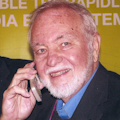If you are an EE you definitely know the answer to this, or at least you think you do. If you said positive to negative, you are wrong. Then you remember that current flow is a charge of electrons moving in a conductor and they go from negative to positive. Of course, that is the right answer. So why does everyone usually get this wrong? Simply because this is what they were taught in college. It seems to be a universal convention, but what I can't understand is why colleges don't teach the truth? But then you are wondering, should we really care? And why am I even bringing this up? Just an interest of mine I guess.
As a professor of electronics, once full time and now an adjunct, I teach that current is electron flow then switch over to teaching a positive to negative flow that most colleges and universities insist is the correct way to teach about how circuits work and how to design and analyze them. Most of the textbooks show current arrows from positive to negative. Why is that? Ever since I started teaching, I have asked that question over and over again of professors I meet. All say the same thing in different ways. For example, "That is the way I learned it." Or "All the textbooks show it that way." Or "It is tradition." Some even say that the concept is easier to understand or that all the diode and transistor symbols use arrows that point that way. I don't see it that way at all. Am I really that dense? For me that whole effort is just perpetuating a myth. Why not teach the truth? Say that to any college professor and you will get the argument of a life time. I have never seen so much passion about such a topic. I love to bring this up at faculty meetings every now and then just to witness the chaos.
I suppose tradition is the most of it. In the very beginning, electrical pioneers really didn't know what direction current flowed or what current really was anyway. Some visualized it as juice or a fluid. Others thought it was some undiscovered particle. But they all seemed to agree on a common direction, positive to negative. This has come to be known as conventional current flow. Then in 1897, British physicist Thompson, discovered that current flow was really electrons as he was doing some research on a crt. Nevertheless, even once the truth was known, everyone stuck with the old model. Professors got used to teaching it this way and books were written, standards were established and the rest is history. End of story.
I came to engineering by way of the technician route. I learned electronics in a technical school and was taught that current flow was electron flow and all circuit analysis was done that way. Even the textbooks for techs showed the real truth of negative to positive flow. Still do. And the military also teaches negative to positive flow. I still lapse into the negative to positive mode when teaching although the colleges still insist that we emphasize conventional flow. I never saw it as a handicap. In fact, what is so difficult that a professor cannot teach both? Students are definitely smart enough to grasp the difference. Why obfuscate, shun or mock the truth as often happens in academia?
One quirky thing that really nags me is that many textbook publishers actually go to the trouble and expense of creating two versions of their texts, one with conventional flow and another with electron flow. If they don't get the direction right, professors won't adopt the book. Silly, huh? But that is the way of the academic world. One would not like to get caught teaching current flow the "wrong" way.
In the end, I guess it really doesn't matter. When we are designing these days, who cares? Even advanced network analysis with mesh or nodal solutions is done with software where as in the past you had to really pay attention to which way you drew the arrows.
A non-issue. Why am I even discussing this? Does anyone really care?
About the Author

Lou Frenzel Blog
Communications Technology
Click here to find more of Lou's articles on Electronic Design.